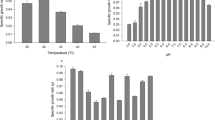Abstract
Although xylose is a major constituent of lignocellulosic feedstock and the second most abundant sugar in nature, only 22% of 3,152 screened bacterial isolates showed significant growth in xylose in 24 h. Of those 684, only 24% accumulated polyhydroxyalkanoates after 72 h. A mangrove isolate, identified as Bacillus sp. MA3.3, yielded the best results in literature thus far for Gram-positive strains in experiments with glucose and xylose as the sole carbon source. When glucose or xylose were supplied, poly-3-hydroxybutyrate (PHB) contents of cell dry weight were, respectively, 62 and 64%, PHB yield 0.25 and 0.24 g g−1 and PHB productivity (PPHB) 0.10 and 0.06 g l−1 h−1. This 40% PPHB difference may be related to the theoretical ATP production per 3-hydroxybutyrate (3HB) monomer calculated as 3 mol mol−1 for xylose, less than half of the ATP/3HB produced from glucose (7 mol mol−1). In PHB production using sugar mixtures, all parameters were strongly reduced due to carbon catabolite repression. PHB production using Gram-positive strains is particularly interesting for medical applications because these bacteria do not produce lipopolysaccharide endotoxins which can induce immunogenic reactions. Moreover, the combination of inexpensive substrates and products of more value may lead to the economical sustainability of industrial PHB production.



Similar content being viewed by others
References
Altschul SF, Madden TL, Schaffer AA et al (1997) Gapped BLAST and PSI-BLAST: a new generation of protein database search programs. Nucleic Acids Res 25:3389–3402. doi:10.1093/nar/25.17.3389
Ausubel E, Brent R, Kingston RE et al (1992) Short protocols in molecular biology. Wiley, New York
Chen GQ, Wu Q (2005) The application of polyhydroxyalkanoates as tissue engineering materials. Biomaterials 26:6565–6578. doi:10.1016/j.biomaterials.2005.04.036
Gomez JGC, Rodrigues MFA, Alli RCP et al (1996) Evaluation of soil gram-negative bacteria yielding polyhydroxyalkanoic acids from carbohydrates and propionic acid. Appl Microbiol Biotechnol 45:785–791. doi:10.1007/s002530050763
Gosset G (2005) Improvement of Escherichia coli production strains by modification of the phosphoenolpyruvate:sugar phosphotransferase system. Microb Cell Fact 4(1):14. doi:10.1186/1475-2859-4-14
Gouda MK, Swellam AE, Omar SH (2001) Production of PHB by a Bacillus megaterium strain using sugarcane molasses and corn steep liquor as sole carbon and nitrogen sources. Microbiol Res 156:201–207. doi:10.1078/0944-5013-00104
Jeffries TW, Jin YS (2004) Metabolic engineering for improved fermentation of pentose by yeasts. Appl Microbiol Biotechnol 63:495–509. doi:10.1007/s00253-003-1450-0
Keenan TM, Tanenbaum SW, Stipanovic AJ et al (2004) Production and characterization of poly-β-hydroxyalkanoate copolymers from Burkholderia cepacia utilizing xylose and levulinic acid. Biotechnol Prog 20:1697–1704. doi:10.1021/bp049873d
Keenan TM, Nakas JP, Tanenbaum SW (2006) Polyhydroxyalkanoate copolymers from forest biomass. J Ind Microbiol Biotechnol 33:616–626
Kumar S, Tamura K, Nei M (2004) MEGA3: integrated software for molecular evolutionary genetics analysis and sequence alignment. Brief Bioinform 5:150–163. doi:10.1093/bib/5.2.150
Lee SY, Choi JI, Song JY (1999) Removal of endotoxin during purification of poly(3-Hydroxybutyrate) from Gram-negative bacteria. J Appl Microbiol 65:2762–2764
Nonato RV, Mantelato PE, Rossel CEV (2001) Integrated production of biodegradable plastic, sugar and ethanol. Appl Biotechnol 57:1–5. doi:10.1007/s002530100732
Pirt SJ (1975) Principles of microbe and cell cultivation. Blackwell Scientific Co, London (ISBN-0-63208150-3)
Piza FF, Prado PI, Manfio GP (2004) Investigation of bacterial diversity in Brazilian tropical estuarine sediments reveals high actinobacterial diversity. Antonie Van Leeuwenhoek 86:317–328. doi:10.1007/s10482-005-0162-0
Reddy CSK, Ghai R, Rashmi VC (2003) Polyhydroxyalkanoates: an overview. Bioresour Technol 87:137–146. doi:10.1016/S0960-8524(02)00212-2
Rocha RCS, Silva LF, Taciro MK et al (2008) Production of poly(3-hydroxybutyrate-co-3-hydroxyvalerate) P(3H-co-3HV) with a broad range of 3HV content at high yields by Burkholderia sacchari IPT 189. World J Microbiol Biotechnol 24:427–431. doi:10.1007/s11274-007-9480-x
Saha BC (2003) Hemicellulose bioconversion. Microbiol Biotechnol 30:279–291. doi:10.1007/s10295-003-0049-x
Schlegel HG, Lafferty R, Krauss I (1970) The isolation of mutants not accumulating poly-β-hydroxybutyric acid. Arch Mikrobiol 38:209–222. doi:10.1007/BF00422356
Silva LF, Gomez JG, Oliveira MS et al (2000) Propionic acid metabolism and poly-3-hydroxybutyrate-co-3-hydroxyvalerate (P3HB-co-3HV) production by Burkholderia sp. J Biotechnol 76:165–174. doi:10.1016/S0168-1656(99)00184-4
Silva LF, Taciro MK, Michelin MER et al (2004) Poly-3-hydroxybutiyrate (P3HB) production by bacteria from xylose, glucose and sugarcane bagasse hydrolisate. Ind Microbiol Biotechnol 31:245–254
Slepecky RA, Hemphill HE (2006) The genus Bacillus—non-medical. In: Dworkin M (ed) The prokaryotes: a handbook on the biology of bacteria, vol 4, 3rd edn. Springer, New York, pp 462–530
Tao H, Gonzalez R, Martinez A et al (2001) Engineering a homo-ethanol pathway in Escherichia coli: increased glycolytic flux and levels of expression of glycolytic genes during xylose fermentation. J Bacteriol 183:2979–2988. doi:10.1128/JB.183.10.2979-2988.2001
Tokiwa Y, Ugwu CU (2007) Biotechnological production of (R)-3-hydroxybutyric acid monomer. J Biotechnol 132:264–272. doi:10.1016/j.jbiotec.2007.03.015
Valappil SP, Boccaccini AR, Bucke C et al (2007) Polyhydroxyalkanoates in Gram-positive bacteria: insights from the genera Bacillus and Streptomyces. Antonie Van Leeuwenhoek 91:1–17. doi:10.1007/s10482-006-9095-5
Valappil SP, Rai R, Bucke C et al (2008) Polyhydroxyalkanoate biosynthesis in Bacillus cereus SPV under varied limiting conditions and an insight into the biosynthetic genes involved. J Appl Microbiol 104:1624–1635. doi:10.1111/j.1365-2672.2007.03678.x
Young FK, Kastner JR, May SW (1994) Microbial production of poly-β-hydroxybutyric acid from d-xylose and lactose by Pseudomonas cepacia. Appl Environ Microbiol 60:4195–4198
Zhang H, Obias V, Gonyer K et al (1994) Production of polyhydroxyalkanoates in sucrose-utilizing recombinant Escherichia coli and Klebsiella strains. Appl Environ Microbiol 60:1198–1205
Acknowledgments
The authors would like to thank to Dr. Vivian Pelizzari for providing Antarctic soil samples and the Fundação de Amparo à Pesquisa do Estado de São Paulo (FAPESP) for financial support.
Author information
Authors and Affiliations
Corresponding author
Rights and permissions
About this article
Cite this article
Lopes, M.S.G., Rocha, R.C.S., Zanotto, S.P. et al. Screening of bacteria to produce polyhydroxyalkanoates from xylose. World J Microbiol Biotechnol 25, 1751–1756 (2009). https://doi.org/10.1007/s11274-009-0072-9
Received:
Accepted:
Published:
Issue Date:
DOI: https://doi.org/10.1007/s11274-009-0072-9




